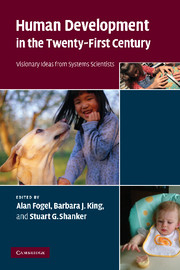Book contents
- Frontmatter
- Contents
- List of contributors
- Introduction: Why a dynamic systems approach to fostering human development?
- Part I Dynamic relationships between genetics and environments
- Part II The dynamic system of the child in the family
- Part III The dynamic system of the child in social and physical environment
- Part IV Dynamic systems approaches to mental health
- 17 A dynamic developmental model of mental health and mental illness
- 18 Dyadic microanalysis of mother–infant communication informs clinical practice
- 19 Current problems of Japanese youth: some possible pathways for alleviating these problems from the perspective of dynamic systems theory
- 20 A different way to help
- 21 Why do siblings often turn out very differently?
- 22 A dynamic systems approach to understanding family and peer relationships: implications for effective interventions with aggressive youth
- 23 Prenatal substance exposure and human development
- Part V Conclusions and outlook
- Index
- References
20 - A different way to help
Published online by Cambridge University Press: 22 September 2009
- Frontmatter
- Contents
- List of contributors
- Introduction: Why a dynamic systems approach to fostering human development?
- Part I Dynamic relationships between genetics and environments
- Part II The dynamic system of the child in the family
- Part III The dynamic system of the child in social and physical environment
- Part IV Dynamic systems approaches to mental health
- 17 A dynamic developmental model of mental health and mental illness
- 18 Dyadic microanalysis of mother–infant communication informs clinical practice
- 19 Current problems of Japanese youth: some possible pathways for alleviating these problems from the perspective of dynamic systems theory
- 20 A different way to help
- 21 Why do siblings often turn out very differently?
- 22 A dynamic systems approach to understanding family and peer relationships: implications for effective interventions with aggressive youth
- 23 Prenatal substance exposure and human development
- Part V Conclusions and outlook
- Index
- References
Summary
It is difficult to watch. On a videotape is a mother and a baby. Something is off. The infant, reclining in a plastic seat, looks ill at ease. He makes small fussing sounds. The mother, facing him, has a broad smile, and says, “What is going on? Are we a little annoyed? A little annoyed?” Her voice is rapid, high-pitched, friendly rather than aggressive. But the more they trade these signals back and forth, the more upset the child becomes.
This mother has been sent for therapy. She has mixed feelings about coming. Legally the court has required her to seek help at our unit. It is a mandated case of a rather typical kind. She is a single mother, somewhat isolated, in difficult economic straits, trying to make do with a four-month-old baby. The baby is not easy to handle, and on her side she feels inexperienced as a parent, and frightfully unsure of herself.
She is also a person prone to rage attacks. This goes on all too often between her and David, the infant. Recently in the night she lost it. David was crying intensely. She had already been up with him several times that night; nothing she had tried seemed to help. She grabbed him and started screaming. She shook him so violently he had to be brought later to a hospital emergency room. In that moment she lost control, it was all she could do to keep from throwing him against the wall.
- Type
- Chapter
- Information
- Human Development in the Twenty-First CenturyVisionary Ideas from Systems Scientists, pp. 200 - 205Publisher: Cambridge University PressPrint publication year: 2007
References
- 4
- Cited by

